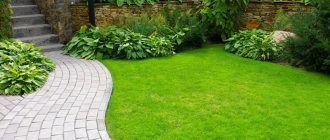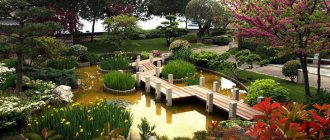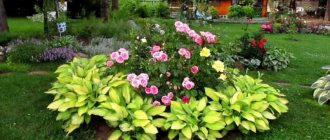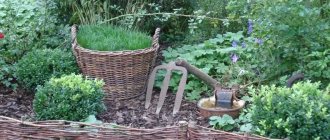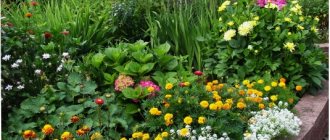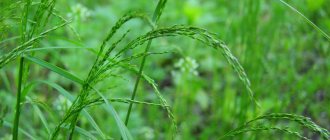Home Landscape Design Garden Ideas
Designing natural gardens requires a lot of knowledge, experience and the ability to listen to wildlife.
By using beautiful wooden decor and an alternative to the traditional lawn, you can win in terms of aesthetics and environmental friendliness. And by using an unusual design of the garden landscape, you can get an unusual paradise for relaxation. Watch the natural garden in the video, which illustrates all its attractiveness and aesthetics for lovers of living natural nature:
At first glance, it may seem that “organic garden” and “natural garden” are identical concepts. But it's not the same thing. The natural style proposed by landscape architects is a skillfully made imitation of natural plant communities where aesthetic harmony is achieved. An organic garden is, rather, a reflection of the philosophy of harmonious coexistence with nature. Its aesthetics also follows from the principles of organizing life in such a garden.
- 2 Beautiful wooden decor for a wooden garden
- 3 Lawn ground cover grasses as an alternative: what can replace a lawn
Natural landscape in natural style garden design
A garden in a natural style is by no means about bright colors, pretentiousness and glossy decor. Elements that unobtrusively fit into the environment are more appropriate here.
The natural landscape in the garden leaves no room for plastic, plaster sculpture, painted gnomes and artificial frogs. If the benches are wooden, instead of sculptures bought on the way to the dacha at garden scraps, there are carts with flowers, instead of clay frogs, there are real ones. Furniture in the garden should not be made of plastic either. A wooden one would be more appropriate. Even for tying up plants, it is better to use bast rope.

Natural landscape in the garden in the photo

Natural landscape in the garden in the photo
Natural garden design means no plastic containers for flowers - only ceramics! Or, as a last resort, you can hide the plastic in wicker baskets. Plastic curb strips are also prohibited. Only natural materials - wood, ceramics, even cut branches are used.
We have to agree that plastic looks bad in the garden. Despite its comparative durability, this product of civilization is alien to any garden. All these plastic chairs, fences, restrictive tapes, even skillfully made “stones” made of plastic only spoil any garden.
Planting a flower garden of perennials and ornamental grasses in a natural style
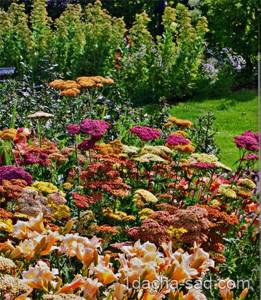
Good afternoon, dear subscribers! In this material we will talk about creating a flower garden from perennials and ornamental grasses in a natural style.
For a long time, lush ridges and a strictly defined garden plan were synonymous with the grace of garden art. With the growth of industrialization, people began to need more and more the natural manifestations around them. Nowadays, excessive rigor and straight lines are not in fashion, but the natural, natural beauty of the garden’s appearance now comes first.
Indeed, the eye very clearly distinguishes deliberateness from naturalness, and a person will always internally strive for what is externally similar to nature. Some landscape designers imitate areas of the natural landscape such as meadows, forests, deserts and even swamps.
These landscapes are populated with plants that are capable of living and reproducing in an ecosystem, next to their usual “neighbors” and which do not require the careful supervision of a gardener.
A landscape design that uses a combination of perennials and ornamental grasses has gained great popularity.
Here are examples of such successful neighborhoods:
- feather grass and pennisetum with sage and rudbeckia (imitation meadow)
- irises with lipweed and snake knotweed (imitation of the lake shore ecosystem)
In order to recreate the picture of natural nature in your garden, you need to take into account the characteristics of the herbs and flowers that you want to use. What is important to know about these plants is the speed of growth, height, color of leaves, when they bloom, size and color of flowers.
Professionals also advise creating familiar living conditions for the plants you want to plant in your garden. In this case, sunlight, average air temperature, soil composition and humidity are very important. In order for a flower garden in this style to please you for many years, you need to calculate everything and prevent plants from competing for sunlight and moisture.

In this bed of perennials and herbs you will find centranthus, sage and yarrow, which get along well together.
Plant composition
If you are planting a flower garden in a natural style, then listen to these tips on plant distribution:
- ground cover (low plants) - 50% of the area
- plants of medium height - 35-45% of the total area
- tall plants - 5-15% of the total area
Most herbs and perennials do not bloom until June-July, so it is a good idea to plant spring flowers between them: such as daffodils, crocuses, tulips. The use of large stones or pebbles will very well maintain the naturalness of the landscape.
There are several more techniques that will enhance the perception of your garden as a natural corner - using Moorish or clover crops instead of the usually green lawn, and gravel or grass instead of paved paths.
Example of flower beds

1. In this natural corner you can find a pleasant natural atmosphere - there is a pond and plants corresponding to it: sedge, iris, hosta, buten, chistous, fern. It seems that we are in a real forest, and not in a man-made garden.
2. If there is a shady place in your garden, then a good solution for it would be to plant brunnera, bergenia, and hosta.
3. And in this corner of the garden they planted ragwort and mantle, which grew greatly thanks to the large free area.
Share link:
- Click here to share content on Facebook. (Opens in a new window)
- Click to share on Reddit (Opens in new window)
- Click to share on Pinterest (Opens in new window)
Beautiful wooden decor for a wooden garden
Any self-respecting English gardener will prefer beautiful garden decor, objects and tools made from natural materials, preferably vintage ones, even slightly touched by rust. By the way, they never paint anything, leaving it to age naturally.
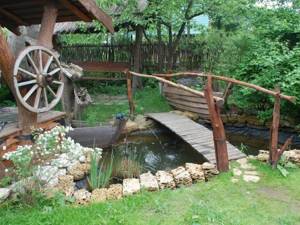
Wooden garden decor

Wooden garden decor
Decor for a garden made of wood can be functional, for example, some sticks and branches are used as supports for annually growing perennials, for example, the stems of last year's raspberries or the branches of pruned apple trees.

Wooden arches and pergolas are built for roses

Wooden arches and pergolas are built for roses
For roses, wooden capital arches and pergolas are built; ship ropes, which were once the rigging of ships, are often used, which is not surprising for a once great maritime power. This tradition has existed for more than one century. And no synthetic ropes - only natural twine.
The same can be said about plastic tags. It’s clear that it’s convenient, but maybe try to do something instead?

Wooden decor for the garden
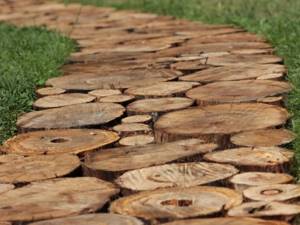
Wooden decor for the garden
Wooden garden decor is literally lying under the gardener’s feet. If you visit the site in winter, cut several sticks of willow, hazel or rowan as thick as your index finger. They make wonderful eco-friendly labels for the vegetable garden and flower garden. By spring they will dry out and will not be able to take root. Cut blanks 20 cm long from these sticks, sharpen one side like a pencil. On the other hand, make a longitudinal section on which the name of the plant is written with a permanent marker - very simple and economical.
Features of the forest style
The main advantage of this style is the minimum requirements for garden care. Gardens designed in this way can develop over decades and change their appearance without human intervention. In a forest garden, it is allowed to leave the area uncleaned after the leaves have fallen, and the grass not mowed. You only need to care for fruit and berry plants. The forest style is characterized by the following factors:
- The entire territory is used for landscaping, leaving small areas in which gazebos or pavilions are placed.
- In such a garden you will not see mowed lawns, concrete or paved paths, classical-looking flower beds or large architectural sculptures.
- The material used to decorate a forest garden is natural stone or wood.
- The garden has many winding, comfortable narrow paths, which are lined with loose materials. The paths are not framed by curbs and do not have clear straight lines.
- Plants already growing in the area are actively used when decorating the garden. Harmonious partners are selected for them, thus creating a forest oasis.
- The overall plan of the garden features dominant plants, flowering accents and decorative plantings. All plants are selected according to certain rules, combining them in such a way as to create an imitation of a wild landscape.
- In a garden of this style, accents are made of natural or precious objects. The plantings should have the appearance of natural thickets, there should be no ridges or flower beds, there should be a pond decorated as naturally as possible with unclear boundaries and large plants creating the effect of a wild forest.
- If there is a relief area, cascade plantings are formed, if the area is flat, rock gardens and natural-looking alpine slides are created.
Plants are planted in the forest garden, classifying them into two zones:
- Lush thickets are formed from group plantings of bushes, as well as skeletal plantings and background plants that replace flower beds.
- Flat areas are formed in such a way as to create a feeling of spaciousness. It is decorated with harmonious elements that make the area bright and sunny. Moorish lawns and clearings, covered with ground cover or moss plants, look great in such places.
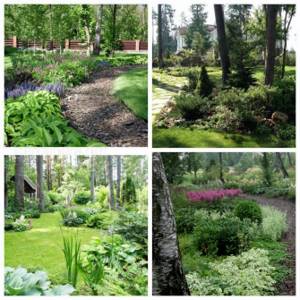
Plants for a forest style garden
The main plants in a forest garden are trees. The formation of the site begins with them. It is very important to choose the right varieties and types of trees. The combination of silhouettes, crown density, bark color, texture and height of the tree should be taken into account. To revitalize the garden and add some “zest” to it, trees with different leaf colors are planted.
Frequent residents of the garden are mighty oaks, slender birches, spreading walnuts, popular maples, weeping willows, conifers, ornamental apple trees and other fruit trees.
The next group of plants are shrubs, which are planted under trees in the undergrowth and on the edges. The following are often used for them: fieldfare, yew bush, white snowberry, blackberry bush, holly, currant berry, raspberry bushes, whiteberry, wolf's bast. The main emphasis should be on cultures that convey the spirit of your area and are found everywhere in it. The following will also help to beautifully decorate the garden: common bird cherry, lispedeza, shadberry lamarcka, clerodendrum bunge, red viburnum, unusual mackerel, variegated euonymus, hazel, fluffy juniper, spirea shrub, common lilac, coniferous plants, sea buckthorn berry, red elderberry, European hornbeam, hawthorn bush, useful rose hips and others. They are used:
- For planting as a hedge around the entire perimeter of the garden, as well as for delimiting areas within the garden.
- To create a thick rich background.
- To transfer crown volume.
- For artificial creation of dense thickets.
When designing ponds, plants are used that complement the reservoirs in wildlife. Among them: willow, swamp myrtle, blackthorn, alder, southern reed, and lake reed.
A forest garden is not complete without liana-like plants, which are used to camouflage structures and give them the appearance of antiquity. For this purpose, climbing hydrangea, rotundifolia, virgin grapes, aristolochia or kirkazon, and common ivy are used. Such plants can create nooks and a neglected look in the right places.
Ordinary ferns are planted from ornamental plants, which can highlight and fill the garden. Along with the ferns, the beautifully flowering Rogersia is also planted. The main perennial that is widely planted in forest gardens is garden geranium. It can create an effective accent by combining dark and light leaves with a beautiful pattern. Also, with the help of geraniums, they create the appearance of ruins and ancient plantings, introducing improvisation and sophistication.
Another plant that is often used to decorate a forest-style plot is rhubarb, the large leaves of which create an appearance of luxury and fit harmoniously into the forest landscape. It is partnered with green hellebore, fragrant oregano, perennial astilbe, popular lemon balm, herbaceous hosta, healthy mint, heuchera or coral bells, comfrey or larkspur, beautiful daylilies, fast-growing loosestrife, bitter weed or epimedium, basilisk, volzhanka and ornamental grasses.
When choosing ground cover plants, they give preference to shade-tolerant specimens, such as European hoofweed, blue lungwort, epimedium, creeping tenacious, oak speedwell, violet or Saintpaulia, green grass, common saxifrage, budra, rosewood, wild strawberry and duchesne.
When planting flowering plants, preference is most often given to anemones or anemones, bulbous primroses, blue scillas, dense corydalis, fragrant lilies of the valley, spring crocuses, fragile snowdrops, as well as various bells, speedwell, ordinary buttercups, bright primrose, astilbe, loosestrife, forget-me-not or Brunner.
The advantage of this style is its versatility and ease of care. The unique microclimate that is created inside the garden has a beneficial effect on the physical and mental state of a person.
Decorative items in a forest garden style
In a forest garden you will not see bright garden figures, fountains or elaborate objects. This style uses accessories that emphasize and enhance the atmosphere of wild nature.
- These include: artificial garden ruins of different sizes, which can emphasize the passage of time and display the overall appearance of the garden in a different way.
- Forgotten elements, such as a garden lantern covered in patina, a broken jug with ivy shoots, a stone sculpture covered in moss, and vintage-looking animal figures.
- Natural decor from saw cuts and wooden log houses are often used. These can be logs that are used as a sofa or hemp as chairs.
Lawn ground cover grasses as an alternative: what can replace a lawn
An alternative to a lawn gives a clear negative answer to the question of whether an ecological garden needs a classic lawn. To answer this question, it is worth turning to the experience of the British, big lawn lovers. According to recent observations, they are moving away from the practice of total grass cutting. The fact is that the constant mowing of lawns and the endless use of chemicals against literally everything that moves has led to very sad consequences. Beneficial insects, ladybugs, lacewings, bumblebees and dragonflies began to disappear from gardens. The disruption of the ecological balance has led to the invasion of aphids and other garden pests. This required even more use of insecticides, and so on in a circle. Therefore, now, where possible, natural vegetation is left untouched in large areas, in the gardens of large estates, and in floodplains. This helps restore not only the insect population, but also helps attract birds that build nests in such thickets - nightingales, robins, partridges, pheasants, etc.

Lawn at the dacha

Grass in the country
You can replace the lawn with simple rules of agricultural technology: sod is maintained in orchards. By mid-summer, unmown grasses form real pampas there, but this does not bother anyone; paths in the garden are cut to the width of a lawn mower, and everything else remains untouched. Butterflies flutter freely in the grasses, bumblebees work, pollinating flowers, bees collect nectar. Such a pastoral picture can be seen in many gardens.
Attempts to create the perfect lawn in a single area, as a rule, fail. And how could it be otherwise if the neighbor’s dandelions fly to your site in any weather. If you don’t fight them, then all efforts to maintain your lawn come to nothing. Once you ease up on weed control, your initially beautiful lawn turns into something just the opposite. Therefore, it is important to know what to replace the lawn with in order to obtain not only aesthetic pleasure, but also practical benefits for the biocenosis of the area.
So maybe it’s not worth spending so much effort on first creating a classic lawn and then maintaining it in perfect order? Maybe instead, use those plants that annoy you to serve you? After all, in fact, there are no weeds in nature, but only wild herbs. They become weeds only in our garden and vegetable garden next to cultivated plants.

Clover in the country

pink clover
Why not sow the area, for example, with white clover? This is an excellent ground cover lawn: clover forms a dense low cover, is drought-resistant, does not get trampled, does not need to be mowed and does not freeze. It is able to grow even in light shade. In addition, being a member of the legume family, clover enriches the soil with nitrogen and does not require fertilizing. And it is also an excellent honey plant, a favorite plant of bees and bumblebees. Well, isn't it a miracle?
A garden plot sown with clover may well become an excellent alternative to a regular lawn, which must be frequently mowed, fed, weeded, etc. Therefore, when arranging an ecological garden, you can do without trivial solutions. Another option when using lawn ground cover grasses is meadow lawn or decorative Moorish lawn, which need to be cut once, in the fall, when the grasses and meadow flowers begin to self-sow.
Try not to cut the grass in your garden completely. Let there be wild thickets here and there. And in the orchard, if you don’t have a swing there and don’t have a place to rest, leave the grass uncut until the fall, let it grow and ear. Cut only the “paths”.
- Author: admin
Rate this article:
- 5
- 4
- 3
- 2
- 1
(1 vote, average: 5 out of 5)
Share with your friends!
Naturgarden style in landscape design: fashion for naturalness
Landscape design studio "ADSK Group": ordering landscape design at a profit, 04/06/2020
After building and furnishing a cozy and comfortable country house, the owners are faced with the need to improve the site. Which is quite logical, because it is in the yard, in the fresh air, during the entire warm season, that the lion's share of time is spent. And enjoying the convenience and beauty of a stylish, landscaped local area is much more pleasant. Among the variety of trends, in recent years the Naturgarden style has become increasingly in demand in the landscape design of country houses and dachas, which we will examine in more detail.
Basics of Naturgarden stylistics
Just as the regular style is otherwise called French, and the landscape style English, the Nattergarden style has other designations - natural garden, eco-garden, new wave and others. The founder of this trend is considered to be the Dutchman Piet Oudolf, who in the middle of the last century began to actively design gardens in a natural, as natural as possible, deliberately careless style. In fact, naturgarden in landscape design is a variation of the classic landscape style that came to us from England, but somewhat modified. As in the original version, the garden and park area does not suffer any radical changes; its true beauty is only emphasized. Despite the apparent chaos of the natural image, as in the English garden, in the Udolphian garden man-made park compositions are created that replicate the natural landscape. The characteristic features of regular and similar styles are unacceptable:
- straight geometric lines;
- complex figured flower beds;
- topiary;
- paths paved with tiles or paving stones;
- elaborate fountains;
- garden sculptures;
- exotic plants.
That is, everything that combines garden styles with pronounced artificiality, which emphasizes human intervention and his power over everything and everyone, is unacceptable. On the contrary, a corner of nature is being recreated on the site, albeit man-made, albeit thoughtfully and carefully composed, but in such a way that, looking at it, you can forget that there is a busy highway literally outside the gates, and a metropolis not far away. The main association that arises in the Udolfian garden is wild meadows, characteristic of the middle zone, which is not surprising, because the climatic conditions in the countries are similar. Perhaps this is why the Naturgarden style was so attractive not only to the Dutch, but also to our compatriots, especially those whose plots are larger than the standard six hundred square meters. In cramped conditions, it is problematic to completely recreate the image of wild nature; there is simply not enough space, but a small “piece” is quite possible.
Harmony and peace
A natural garden, even part of it, is an opportunity to feel harmony and peace, take a deep breath and temporarily forget about all the difficulties and problems remaining behind the fence. From the first moments, complete immersion - it seems that the surrounding landscape was created by nature, not man. It is not surprising that in the current life circumstances, many are striving to order landscape design in the Naturgarden style , so that at least they can relax their souls at home. Moreover, a similar effect can be achieved with minimal investment, and the whole trick is in the selection of plants. It is the correct arrangement of species and varieties, moreover, of the simplest and most unpretentious perennials, both flowers and herbs, that gives the feeling of a meadow swaying in the fresh wind. The trick is not only in the layout, but also in the quantity - even if there are only a few species, they are planted in clumps, that is, in compositions, emphasizing each other. With this approach, a Naturgarden-style garden does not require large-scale financial investments, and the result is amazing.
Shape and silhouette
Perhaps the main difference between the new wave and the English landscape is the predominance of silhouette and shape over the color scheme. If the British diluted the noble greenery with bright shades, the Dutch gravitated towards calm, pastel colors and gave preference to the shape of the plants rather than their colorfulness during the flowering period. He arranged flowers and herbs precisely according to the shape of their inflorescences: various panicles, baskets, corollas, umbrellas, balls and “daisies,” as well as stems and leaves form an organic composition. There is an undoubted advantage in this approach - the shape and silhouette are practically unchanged even during the period between flowering, and perennial grasses also remain in their original form for the winter. That is, such a landscape design for a country house looks most advantageous all year round. At the same time, the absence of “flashy” shades is taken for granted, and the pastel palette interspersed with lilac, gold, lilac and all shades of green looks no less expressive and noble. Yes, to those who are accustomed to orderliness and gradation, such a garden may seem unkempt and chaotic, but this is only at first glance. It is not for nothing that Oudolf is considered a master of “beautiful chaos”, that his landscape is unique and all the more valuable.
Low maintenance and unpretentiousness
Last but not least, in the gardens of the eminent Dutchman, followers are attracted by low-maintenance - crops are selected that are unpretentious, resistant to the vagaries of nature, plus, aggressive varieties that can “clog” the rest are completely excluded. Plants do not oppress each other, but coexist peacefully, fully revealing their potential and requiring virtually no care. The natural style of garden design consists of perennial herbs and aerial cereals at the heart of the compositions, diluted with undemanding flowers. Whether it is in the process of flowering, and the herbs are also blooming, whether outside it or during the dormant period, in the rain or hot rays, under gusts of wind or in silence, the garden looks equally attractive. In the gardens of the new wave, cereals act as a backbone, a framework that supports the rest of the perennials and forms a pronounced structure.
Another characteristic feature is the planting density, which exceeds standard recommendations several times. With this approach, minimal care after planting in the form of loosening and mulching is needed only for the first time. Afterwards, the plants on the mixborders grow so much that they suppress the growth of weeds and the intervention of the owners is minimal. And this is a good reason why naturgardentak gardens are popular among summer residents, because they do not require regular weeding, removal of faded inflorescences, or regular watering. Thanks to thickened plantings and mulching, moisture in the soil is retained longer; in rainy regions you don’t have to bother with watering at all, and in dry regions you can get by with a sprinkler or a drip irrigation system.
Nuances of planning the new wave
Tall multi-grass plants need space - the minimum width of a natural flower garden is 2.5 meters, and its length can stretch indefinitely. For example, encircling the entire perimeter of the site, there are a lot of options; fortunately, the naturalistic styles of garden design are as diverse as possible and there is no clear “outline”. But there are several recommendations that must be followed.
- Emphasis on mood, not views - when creating an image, the basis is the mood that the garden should convey, and plants are selected for it, and not vice versa.
- Freedom for self-sowing - there is no pronounced shape of flower beds and clear boundaries, plants that are eliminated and sprouted at random, and allow you to achieve the desired visual effect.
- Beauty all year round - plants are selected proportionally according to the flowering period: 30% should bloom all spring, another 40% fall in the summer and 25% remain in the fall. In winter, with or without snow, forbs will delight the eye.
Thanks to the popularization of Dutch gardens, today it is not a problem to order a garden design in the Naturgarden style from any specialized company.
